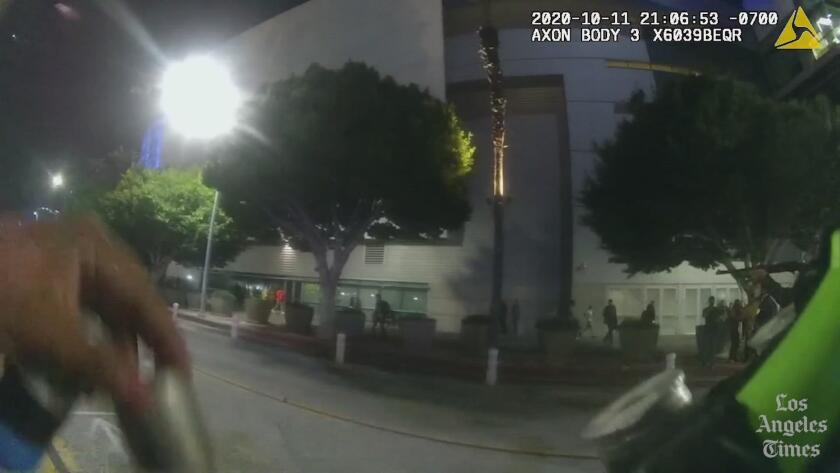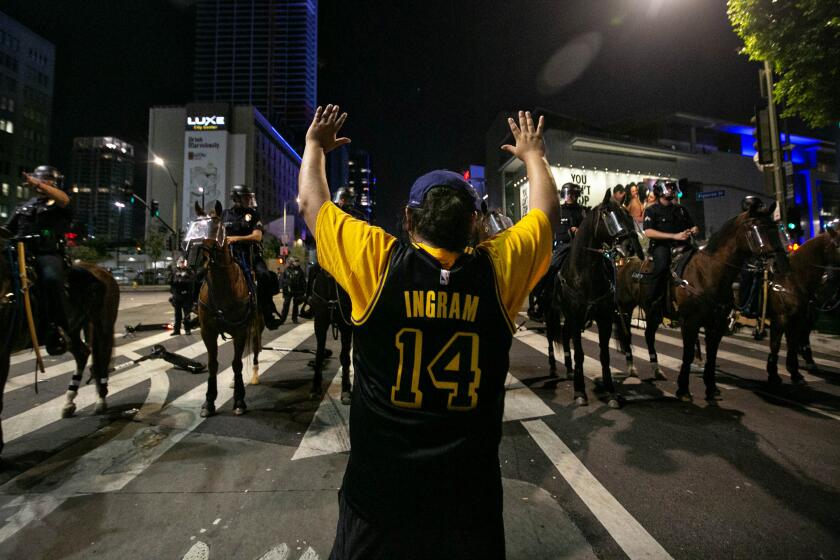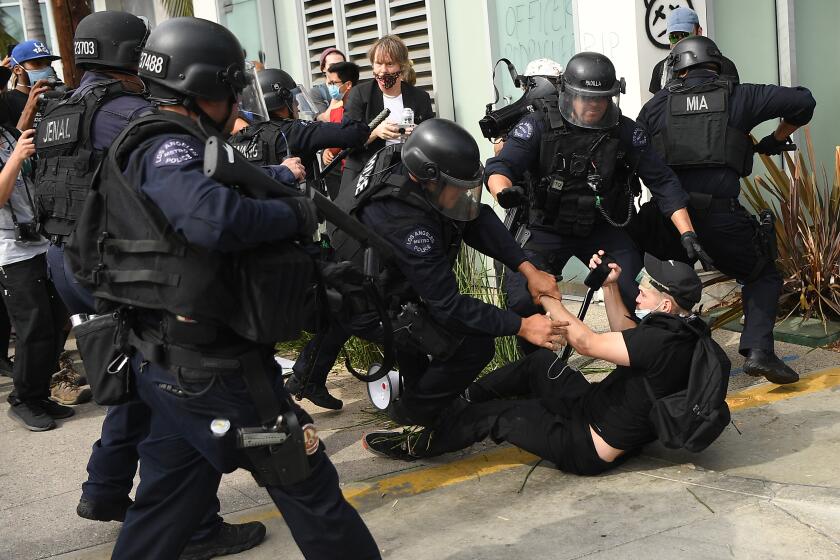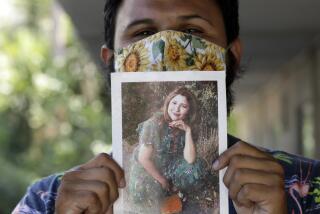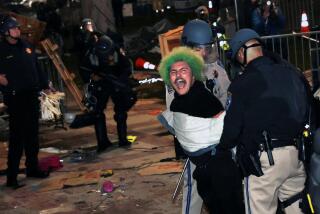Jury awards $1.5 million to woman injured by LAPD projectile during Lakers celebration
- Share via
A jury awarded $1.5 million to a woman who was injured when an LAPD officer shot her with a projectile amid the Lakers 2020 championship celebration.
- Share via
A federal jury has awarded $1.5 million to a woman who suffered a brain injury two years ago when a Los Angeles police officer shot her with a hard-foam projectile as she left the Lakers’ downtown NBA title celebration.
The ruling came after a three-day civil trial that ended Thursday, during which jurors heard evidence of what Kimberly Marroquin’s attorney described as a heavy-handed police response to people thronging the streets following the Lakers’ championship-clinching win in the 2020 NBA Finals. Marroquin argued that she was leaving the celebration and posed no threat to police when she was struck in the head with the projectile. She suffered a traumatic brain injury, she said, from which she still deals with continual headaches and difficulty sleeping.
Marroquin was one of several people who were injured in the area around what was then known as Staples Center. As storefronts were being damaged and some officers targeted with thrown rocks and bottles, Los Angeles Police Department officers declared an unlawful gathering and began firing 40-millimeter “less-lethal” rounds at people. One man’s eye socket was shattered after being struck, and another lost eight teeth when a projectile hit him in the mouth.
Attorney Kevin Conlogue, who filed the lawsuit in the Central District of California on Marroquin’s behalf, argued the Police Department escalated what had been a peaceful, if raucous, celebration by authorizing the use of “less-lethal” munitions. A lack of training and oversight, he claimed, also allowed LAPD Officer Dimaggio Rico to wield a 40-millimeter projectile launcher, even though he lacked the proper certification.
A message for Rico’s attorney wasn’t immediately returned Friday.
The Los Angeles Police Department’s use of so-called less-lethal projectiles for crowd control is facing new criticism after two men were badly injured during the downtown celebration after the Lakers’ championship win.
This, Conlogue said, fit into a pattern of LAPD officers using non-deadly force inappropriately, dating to the May 2020 protests over the police murder of George Floyd in Minneapolis.
Several reports released in the ensuing months pointed to glaring problems with the department’s handling of the Floyd protests, blaming disorder in the streets in part on poor planning, inadequate training and inconsistent leadership.
A filing in the Marroquin case quoted a city official who said the LAPD had been the subject of at least 26 civil lawsuits alleging excessive force and other misconduct related to protests since the summer of 2020.
Spokespeople for the LAPD and the union that represents most rank-and-file officers declined to comment on Thursday’s outcome.
LAPD Capt. Kelly Muniz said that although she wouldn’t comment on a specific case, the department has adopted or is moving forward with several reforms suggested by the after-action reports.
Two more reviews have found glaring problems with the Los Angeles Police Department’s handling of last summer’s mass protests against police brutality.
Among them are a requirement that officers be re-certified in less-lethal weapons every two years and the establishment of a “less-lethal cadre” of officers who will receive additional training for “crowd control and management situations,” she said.
Marroquin had been part of a crowd that converged on the area around what is now Crypto.com Arena on Oct. 11, 2020, but had decided to call it a night around 9:15 p.m. She was walking on the sidewalk near 12th and South Figueroa streets when, “without warning or provocation,” an officer shot her in the head with a less-lethal round, according to her lawsuit.
Conlogue said that he tried to learn the officer’s identity through a records request with the city but was initially told no force had been used at that location during that time and that there was no relevant footage to turn over. After some back-and-forth, a judge ruled that the city would have to release any video of the encounter, he said. The city eventually released about 40 body camera videos.
“The LAPD and city has a pattern and practice of refusing to disclose body-worn camera footage of its officers that depicts unlawful activities on the public streets of the city of Los Angeles,” Marroquin’s lawsuit said.
Police in Los Angeles and other cities have fired 40-millimeter foam bullets at George Floyd protesters, drawing complaints of excessive force.
Police have long defended the use of less-lethal weapons as an effective way to disperse violent crowds without having to use deadly force.
But Conlogue argued that calling such weapons “less lethal” is misleading considering the serious injuries they can inflict in certain situations.
The LAPD has come under heavy criticism in recent years for its reliance on such weapons for crowd control, with some critics calling for their outright ban.
A 2020 Times investigation into police force at mass protests found multiple examples of people being badly wounded by the weapons — with bloodied eyes, head wounds and damaged testicles, among other injuries.
As a result of her injuries, Conlogue said, his client still suffers from lingering migraines and sensitivity to heat and cold. She also still has trouble sleeping, he said.
A protester who was wounded by the LAPD in 2020 and has since received a $1.25-million settlement discusses the grueling legal process and the path forward.
Rico testified during the trial that he had been aiming at a man on the sidewalk whom he suspected of throwing a glass bottle at police, according to a court transcript. But Rico admitted that a group of people who were near the man weren’t engaged in criminal behavior. He also denied seeing Marroquin but admitted he didn’t see for certain who had thrown the bottle, according to the transcript.
On the night of the incident, police arrested at least 76 people for alleged activities including vandalism, unlawful assembly and failure to disperse.
Fans said the celebration turned violent when police responded by firing hard foam and plastic projectiles at throngs of people after bottles and other items were thrown by the crowd.
The LAPD is also facing a major lawsuit from Black Lives Matter Los Angeles and other activists and protesters over its use of projectiles during the summer 2020 protests. The plaintiffs in that case are seeking an injunction to block any future use of the weapons on crowds.
Times staff writer Kevin Rector contributed to this report.
More to Read
Sign up for Essential California
The most important California stories and recommendations in your inbox every morning.
You may occasionally receive promotional content from the Los Angeles Times.
